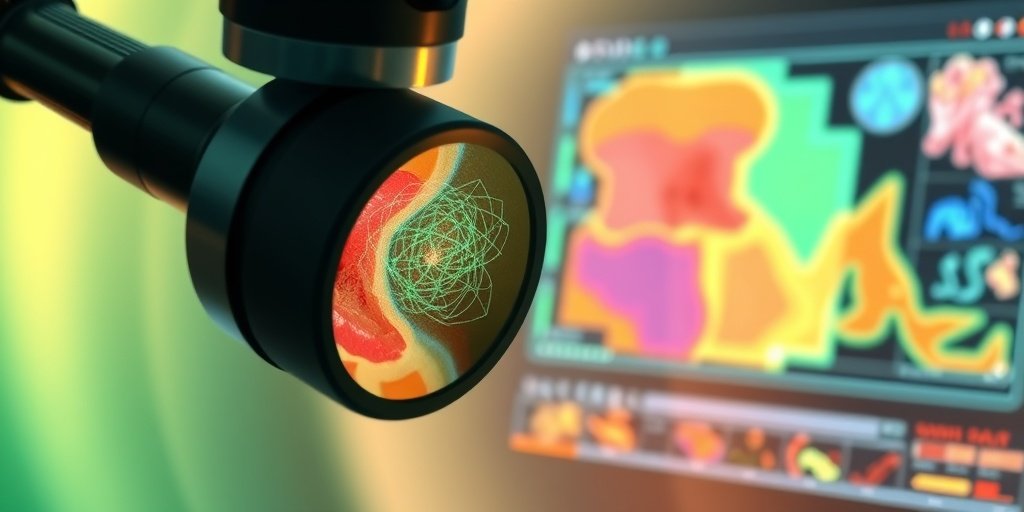⚡ Quick Summary
This study explored the integration of hyperspectral imaging (HSI) and deep learning (DL) to enhance diagnostics in oral health, focusing on a comprehensive dataset of oral tissues. The results demonstrated high performance in tissue classification, with F1-scores reaching 0.857 for the best models, paving the way for improved noninvasive diagnostic techniques.
🔍 Key Details
- 📊 Dataset: 226 participants (166 women, 60 men, aged 24-87)
- 🧩 Features used: Endoscopic hyperspectral imaging data (500-1000 nm)
- ⚙️ Technology: DeepLabv3 and U-Net models for segmentation
- 🏆 Performance: Best F1-scores: DeepLabv3 (0.857), U-Net (0.84)
🔑 Key Takeaways
- 📊 Hyperspectral imaging offers a novel approach to oral tissue diagnostics.
- 💡 Deep learning models were effectively trained for tissue segmentation and classification.
- 👩🔬 The dataset is the first of its kind, addressing a significant gap in oral health imaging.
- 🏆 High F1-scores indicate strong model performance in distinguishing tissue types.
- 🌍 Potential applications include early cancer detection and intraoperative diagnostics.
- 🔬 Variability analysis confirmed the dataset’s complexity and authenticity.
- 🆔 Study published in JMIR Medical Informatics, DOI: 10.2196/76148.

📚 Background
Oral diseases, particularly oral squamous cell carcinoma, present significant challenges due to late diagnosis and the difficulty in differentiating between various oral tissues. Traditional diagnostic methods can be invasive and often lack precision. The advent of hyperspectral imaging combined with machine learning offers a promising solution to these challenges, enabling more accurate and noninvasive assessments of oral health.
🗒️ Study
The study aimed to create a comprehensive, annotated dataset of oral tissues using an endoscopic hyperspectral imaging system. A total of 226 participants were examined, and the spectral data collected was meticulously annotated. The researchers employed advanced deep learning techniques, specifically adapting the DeepLabv3 model for effective segmentation of oral tissues.
📈 Results
The results were promising, with the DeepLabv3 model achieving an impressive F1-score of 0.857, while the U-Net model followed closely with an F1-score of 0.84. Notably, the models excelled in segmenting specific oral structures, such as the mucosa (0.915) and palate (0.90), demonstrating their potential for clinical application.
🌍 Impact and Implications
This study represents a significant advancement in oral health diagnostics. By leveraging hyperspectral imaging and deep learning, healthcare professionals can achieve more accurate and timely diagnoses of oral diseases. The implications extend beyond diagnostics, potentially influencing treatment strategies and improving patient outcomes through early detection and personalized care.
🔮 Conclusion
The integration of hyperspectral imaging with deep learning marks a transformative step in oral health diagnostics. This study not only fills a critical gap in the existing literature but also sets the stage for future innovations in noninvasive tissue analysis. As we move forward, the potential for these technologies to enhance patient care in oral health is immense, and further research is encouraged to explore their full capabilities.
💬 Your comments
What are your thoughts on the use of hyperspectral imaging in oral health diagnostics? We would love to hear your insights! 💬 Join the conversation in the comments below or connect with us on social media:
Enhancing Oral Health Diagnostics With Hyperspectral Imaging and Computer Vision: Clinical Dataset Study.
Abstract
BACKGROUND: Diseases of the oral cavity, including oral squamous cell carcinoma, pose major challenges to health care worldwide due to their late diagnosis and complicated differentiation of oral tissues. The combination of endoscopic hyperspectral imaging (HSI) and deep learning (DL) models offers a promising approach to the demand for modern, noninvasive tissue diagnostics. This study presents a large-scale in vivo dataset designed to support DL-based segmentation and classification of healthy oral tissues.
OBJECTIVE: This study aimed to develop a comprehensive, annotated endoscopic HSI dataset of the oral cavity and to demonstrate automated, reliable differentiation of intraoral tissue structures by integrating endoscopic HSI with advanced machine learning methods.
METHODS: A total of 226 participants (166 women [73.5%], 60 men [26.5%], aged 24-87 years) were examined using an endoscopic HSI system, capturing spectral data in the range of 500 to 1000 nm. Oral structures in red, green, and blue and HSI scans were annotated using RectLabel Pro (by Ryo Kawamura). DeepLabv3 (Google Research) with a ResNet-50 backbone was adapted for endoscopic HSI segmentation. The model was trained for 50 epochs on 70% of the dataset, with 30% for evaluation. Performance metrics (precision, recall, and F1-score) confirmed its efficacy in distinguishing oral tissue types.
RESULTS: DeepLabv3 (ResNet-101) and U-Net (EfficientNet-B0/ResNet-50) achieved the highest overall F1-scores of 0.857 and 0.84, respectively, particularly excelling in segmenting the mucosa (0.915), retractor (0.94), tooth (0.90), and palate (0.90). Variability analysis confirmed high spectral diversity across tissue classes, supporting the dataset’s complexity and authenticity for realistic clinical conditions.
CONCLUSIONS: The presented dataset addresses a key gap in oral health imaging by developing and validating robust DL algorithms for endoscopic HSI data. It enables accurate classification of oral tissue and paves the way for future applications in individualized noninvasive pathological tissue analysis, early cancer detection, and intraoperative diagnostics of oral diseases.
Author: [‘Römer P’, ‘Ponciano JJ’, ‘Kloster K’, ‘Siegberg F’, ‘Plaß B’, ‘Vinayahalingam S’, ‘Al-Nawas B’, ‘Kämmerer PW’, ‘Klauer T’, ‘Thiem D’]
Journal: JMIR Med Inform
Citation: Römer P, et al. Enhancing Oral Health Diagnostics With Hyperspectral Imaging and Computer Vision: Clinical Dataset Study. Enhancing Oral Health Diagnostics With Hyperspectral Imaging and Computer Vision: Clinical Dataset Study. 2025; 13:e76148. doi: 10.2196/76148